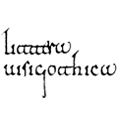Codex of the month (XIV): Madrid, Archivo Histórico Nacional, cód. 1452B
This month I bring you a collection of fragments that might seem poor or unimportant, but that is, nevertheless, a complete guide of Visigothic script through examples. Let’s start from the beginning; what collection? Why is it special?
“Fragmentos de visigodos y visigóticos”
•tweet it
Over the years, for natural reasons or, more frequently, for human action, many of our Visigothic script manuscripts were dismantled. Around the 13th c., when Visigothic script was no longer fashionable in most of the Iberian Peninsula and the Mozarabic liturgy was replaced by the Roman rite, Visigothic script codices, unless extremely special for their illuminations, became appreciated for their raw material instead of for their contents. That is why some codices ended up destroyed, their pages reused for many purposes from providing parchment for new codices to the manufacture of hats or even for making soup during the war, but some others, not particularly beautiful but still relevant, were reused to serve as natural binding for new books. It happened to manuscripts all across Europe in different periods depending on cultural changes and the like.
We have many examples within the corpus of Visigothic script codices of manuscripts that went through that process of rejection and reuse. In some cases, only one small fragment of a bifolium remains, but they are still there! Found, recovered and restored from the last century on within the covers of late medieval or modern books, the specialists had worked with them putting the pieces together and making what is called a composite codex or a codex formed by the miscellany to which they were giving life back. Every single page, even if small and damaged, means a complete codex almost lost. Fragments are therefore significant, thought-provoking: when was the codex pulled apart and why? Is there any other fragment of the same codex? (take a look at this research project on fragments) This month the ‘Codex of the month’ series retrieves from the corpus a collection of such pieces, put together and preserved by the National Archives in Madrid.
The collection
The collection of fragments of Visigothic script manuscripts kept at the National Archive under the shelfmark cód. 1452B contains several fragments of codices and charters (the surviving Visigothic charters; from the Visigothic chancery, not in Visigothic script) dated from the mid-6th to the early 12th c. These fragments of codices, some of them very damaged, can be classified into two groups: those written in Visigothic minuscule script of the Mozarabic type and those also copied in Visigothic minuscule but of the northern variant (you have a brief file of each below).
a) The Mozarabic codices
The fragments from the Mozarabic type correspond to two main production areas of southern Iberia: Córdoba and Toledo. The Cordobese codices, supposedly produced in Córdoba, arrived at the monastery of San Salvador de Oña (Burgos) at an unknown date, where they were reused to serve as binding for 16th c.-notes. From there, they arrived in Madrid in the 19th c. together with the Toletan fragments.
b) The Northern codices
Together with the Mozarabic codices are kept other fragments copied in the same typological variant of the script which, by its graphic characteristics (particularly the ductus), correspond to production centres of northern or north-western Iberia. The prominence of these centres as reflected by the dexterity of the scribes is uneven: the copyist of the first fragment (24) belongs to a secondary centre, whereas the scribes of the other three are considerably skilled (two are linked to the area of Burgos and the other to the Monastery of Celanova, in Galicia). At the same time, the script of each fragment represents a different stage in the evolution of Visigothic minuscule, being the first one a not yet set graphic model while the last one was copied in a transitional Visigothic script, that in transition to Caroline minuscule.
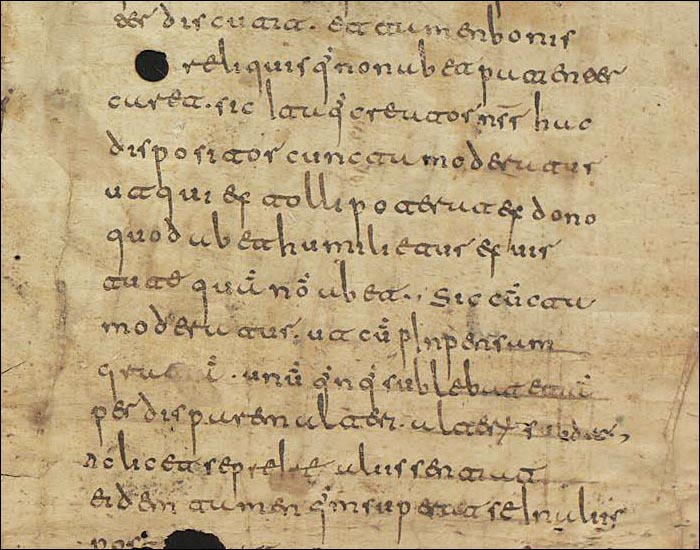 © Madrid, Archivo Histórico Nacional, cód. 1452B, frag. 24. Detail.
© Madrid, Archivo Histórico Nacional, cód. 1452B, frag. 24. Detail.
As I mentioned above, although these are only fragments of codices, the collection provides examples of the most relevant aspects of Visigothic script: they represent the two main geographical variants, and the different primary areas or centres within them, and the three main stages of evolution of the script. They are not complete, they might not be spectacular in appearance, but what these fragments can tell us about production, use, and preservation of medieval manuscripts throughout the centuries is potentially much more interesting than what a perfectly preserved codex can. Surprisingly though, fragments are less studied than full codices – it takes for a good detective to reconstruct their lives!
FILES:
Cordobese codices
1) Fragments 1452B, 1-4 (former cód. 1386, frag, 1): late 9th - early 10th c.
Contents: Gregorius, Moralia in Iob, 15,11-13 (frag. 1),16-17 (frag. 2),49-51 (frag. 3),53 and 59-62 (frag. 4).
Physical description: 5 fols./fragments; fragments 1, 2 and 3 served as binding for Madrid, Archivo Histórico Nacional, Burgos, Oña, leg. 298 and fragment 4 as binding for id. leg. 273 (fol. 1r and 3r as the main cover). 2 quaternions / 2 columns (2 external vertical lines and one line each column making the intercolumn space) / at least 36 lines / ruled in dry point with pricking in the intercolumn space / titles in red.
Notes: It has been assumed this codex served as model for El Escorial, Archivo del Monasterio, R.II.7 (copied in the 13th c.).
References: Díaz y Díaz, Códices, 407-408, nº 128; Millares, Corpus, nº 131.
2) Fragments 1425B, 21 (former cód. 1386, frag. 8): late 9th - early 10th c.
Contents: Bible, Ps. 103,24-108 and Os. 7,4-10,15.
Physical description: 2 fols./fragments, non-consecutive but sewn together; from binding Madrid, Archivo Histórico Nacional, Burgos, Oña, leg. 186 (very damaged). 3 columns (single external vertical lines) / more than 47 lines / pricking in the second intercolumn / ruled by trace.
References: Díaz y Díaz, Códices, 410, nº 133; Millares, Corpus, nº 138.
3) Fragment 1425B, 7 (former cód. 1386, frag. 3): early 10th c.
Contents: Augustinus Hipponensis, In Iohannem, 111,17,24 (PL 35,1925-1927).
Physical description: 1 fol./fragment; served as binding for Madrid, Archivo Histórico Nacional, Burgos, Oña, leg. 316. 2 columns (double external and internal vertical lines) / 32 lines / ruled in dry point / pricking in the intercolumn space.
Notes: Although other copies of Augustinus’ works are preserved within the corpus of Visigothic script manuscripts, this fragment is the only one of this work.
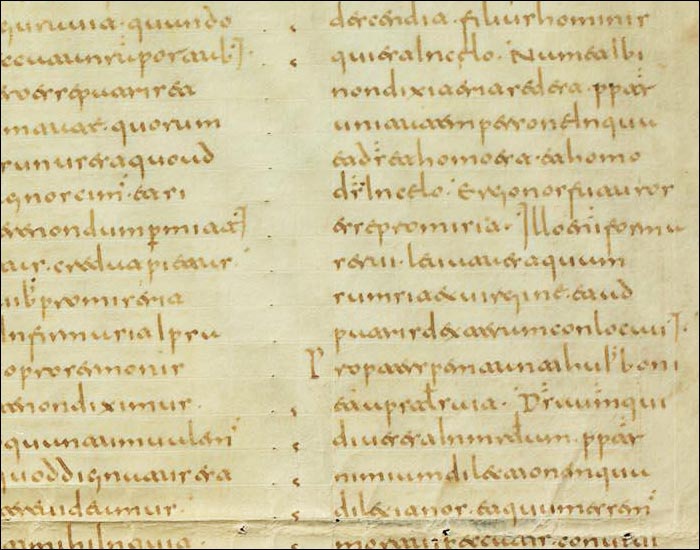 © Madrid, Archivo Histórico Nacional, cód. 1452B, frag. 7. Detail.
© Madrid, Archivo Histórico Nacional, cód. 1452B, frag. 7. Detail.
References: Díaz y Díaz, Códices, 408, nº 130; Millares, Corpus, nº 133.
4) Fragment 1452B, 10 (former cód. 1386, frag. 6): first half 10th c.
Contents: Cassianus, Collationes Patrum, 11,7-8.
Physical description: 1 fol./fragment from binding (Madrid, Archivo Histórico Nacional, Burgos, Oña, leg. 416). 2 columns (double external vertical lines, single line in the middle) / 36 lines / rules in dry point / pricking in the intercolumn space.
Notes: More on this work here.
References: Díaz y Díaz, Códices, 409-410, nº 132; Millares, Corpus, nº 136.
5) Fragments 1452B, 5-6 (former cód. 1386, frag. 2): 11th c.
Contents: Evangeliorum, Luc. 17,28-19,12.
Physical description: 2 fols./fragments; served as binding of Madrid, Archivo Histórico Nacional, Burgos, Oña, leg. 285 and 522. 2 columns (2 external vertical lines and 2 internal lines) / 29 lines / ruled in dry point with pricking in the lateral margins / titles in red.
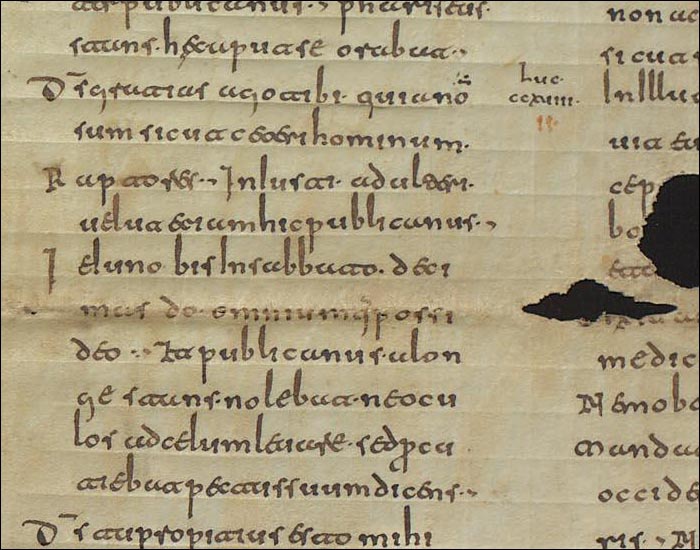 © Madrid, Archivo Histórico Nacional, cód. 1452B, frag. 5-6. Detail.
© Madrid, Archivo Histórico Nacional, cód. 1452B, frag. 5-6. Detail.
Notes: There is no other copy of this oeuvre in Visigothic script.
References: Díaz y Díaz, Códices, 408, nº 129; Millares, Corpus, nº 132.
Toletan codices
1) Fragments 1452B, 8 (+B,20 and B20bis) (former cód. 1386, frag. 4): 10th c.
Contents: Gregorius, Homiliae in Evangelia, 36 (PL 76,1266).
Physical description: 3 fols./fragments; B, 8 served as binding of Madrid, Archivo Histórico Nacional, Burgos, Oña, Documentos reales, tomo VI, doc. 254. 2 columns (double external vertical lines; single lines to mark the intercolumn) / at least 31 lines / pricking in the intercolumn space / ruled by trace.
Notes: Several copies of this work within the corpus.
References: Díaz y Díaz, Códices, 409, nº 131; Millares, Corpus, nº 134.
2) Fragment 1452B, 22 (former 1484B, 7): 11th c.
Contents: Orationale.
Physical description: 1 fol./fragment that served as binding. 2 columns / no visible pricking / ruled in dry point / initials in red.
Script: very neat Visigothic minuscule – Mozarabic variant, probably from Toledo.
Notes: The origin of this codex is unknown, although by its quality and characteristics it could have been copied in Toledo. The provenance listed by the archive links the manuscript to Montearagón (Toledo).
References: Millares, Corpus, nº 140.
The Northern codices
1) Fragment 1452B, 24: 9th c.
Contents: Gregorius, Homiliae in Evangelia (see above).
Physical description: 1 fol./fragment. 2 columns (double external vertical lines, single in the middle) / pricking in the intercolumn / ruled in dry point.
Notes: In the archive’s file, Uclés (Cuenca) is mentioned as its provenance.
References: Millares, Corpus, nº 141.
2) Fragment 1452B, 9 (former cód. 1386, frag. 5): late 9th - early 10th c.
Contents: Paulus diaconus, Vitas Sanctorum Patrum Emeretensium, 5, 9-5,11,13.
Physical description: bifolium from binding (Madrid, Archivo Histórico Nacional, Burgos, Obarenes, Benedictinos, leg. 264). 2 columns (double external vertical lines, single lines in the middle) / 40 lines / no visible pricking.
Notes: This work is significant for it provides detailed information about the controversy of the last years of the reign of Leovigild.
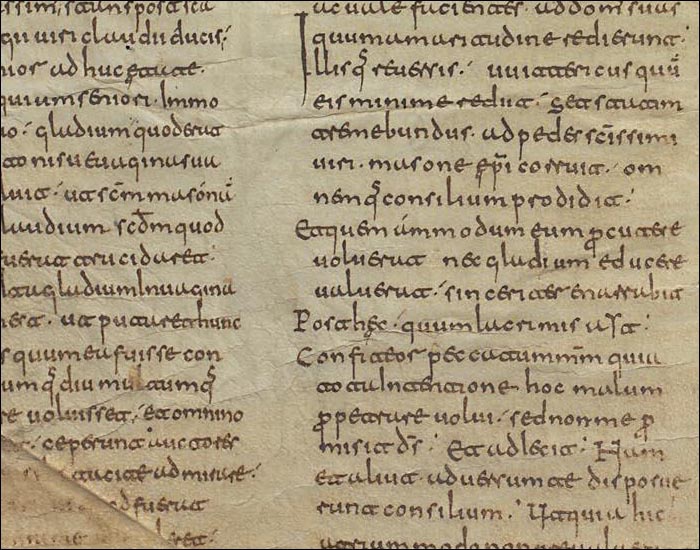 © Madrid, Archivo Histórico Nacional, cód. 1452B, frag. 9. Detail.
© Madrid, Archivo Histórico Nacional, cód. 1452B, frag. 9. Detail.
References: Díaz y Díaz, Códices, 410-411, nº 134; Millares, Corpus, nº 135.
3) Fragments 1452B, 23 (former Diversos, leg. 14) (+Orense, Arch. Capitular, Ms. 43): second half 10th c.
Contents: Excerpta Canonum.
Physical description: 2 fols./fragments that served as binding (Orense, Catedral, Quentas de Mayordomos de la Mesa Capitular). 2 columns (double external vertical lines, single in the middle) / at least 41 lines / pricking in the intercolumn space / titles in red.
References: Díaz y Díaz, Códices, 440-441, nº 171; Millares, Corpus, nº 139.
4) Fragment 1452B, 11 (former cód. 1386, frag. 7): late 11th – early 12th c.
Contents: Gregorius, Moralia in Iob, 15,15-31 (PL 75,1091-1110) (see above).
Physical description: 1 uncut bifolium from binding. 2 columns (double external vertical lines, single in the middle) / 47 lines / pricking in the external guides / initials and titles in red.
References: Díaz y Díaz, Códices, 411, nº 135; Millares, Corpus, nº 137.
by A. Castro
